|
|
Domitian Obelisk (In Piazza Papiniano, Benevento)
| Present Site: | Piazza Papiniano, Benevento, Italy N 41°07'53.9"(41.131635) E 14°46'38.0"(12.777208) |
| Pharaoh: | Roman Emperor Domitian (Domitianus) (AD 1st Century) |
| Measurement: | Unknown |
| Weight: | Estimated 2.5 tons |
| Stone: | Red granite |
About The Site:
Benevento is a small town among mountains, located about 50km northeast of Naples (Napoli), the polulation is about 60,000 including its vicinity.
Benevento was an important point of Appian Way (Via Appia) in the ancient Roman times, leading to the Adriatic coast of Brindisi from Rome. There are the triumphal arch, the Arch of Trajan (Arco de Trajano), and Roman Amphitheater, etc. as the remains of ancient Rome. In addition, although Lombard of Germanic invaded into Italy in 568 after the Roman Empire downfall, Lombard has caused the Duchy of Benevento in Benevento.
In 2011, it became a UNESCO World Heritage Site as part of the seven groups of important buildings as "Longobards (Lombard) in Italy, Places of the Power (AD 568-774)". The church of Santa Sofia in Benevento is one of seven buildings, as one of the main surviving examples of Lombard architecture.
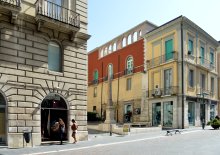
Piazza Papiniano
where the obelisk stands |
How To Get There:
The direct train from Rome Termini to Benevento is available. It's in 2 hours, but you should check the time table in advance as the trains are few.
In terms of distance, Naples is nearer, but the train connection is not convenient. The bus would be the more convenient transportation than trains.
The railroad station of Benevento is far about 500 meters north of center of town. From the station, walk straight the broad street (Via Principe di Napoli) beyond the fountain, and then cross the river (Ponte Calore), and walk straight further, then meet the main street (Corso Giuseppe Garibaldi). Turn left (east direction), and 200 meter beyond, there is a Piazza Papiniano, which is not a wide space, but just like only the building next to the Piazza. The targeted obelisk stands in this small Piazza.
 |
|
|
Notes For Pictures:
When I visited here in August 2014, most shops excluding restaurants were closed due to the summer vacation season, and many companies were off work. Hence the town of Benevento was quiet. Particularly just after noon, it looked like a "ghost town" because nobody was on the street.
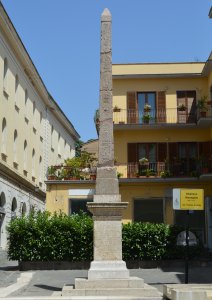 South Side |
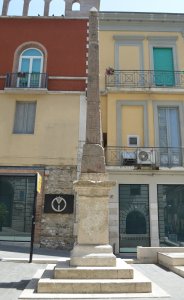 West Side |
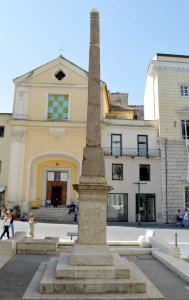 North Side |
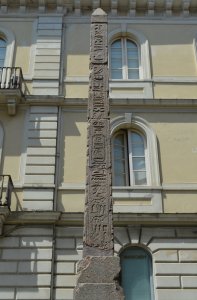 East Side |
|||
August 13, 2014 by Hiroyuki Nagase (For high definition image, please click the picture) | ||||||
Copyright Hiroyuki Nagase nagase@obelisks.org and Shoji Okamoto okamoto@obelisks.org